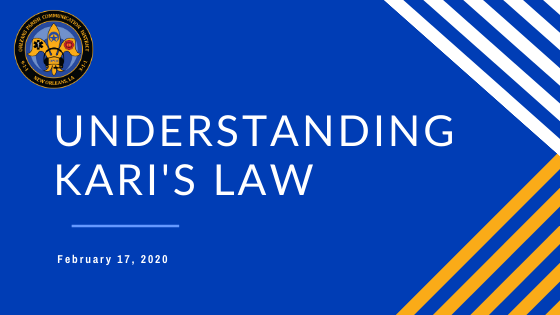
Understanding Kari’s Law
Imagine yourself, a 9-year-old child in a hotel room with your mother and two younger siblings. Mom brought you to this hotel in a small Texas town because this is where Dad lives, now. Mom and Dad do not get along very well anymore, so it’s been a while since you have been able to visit with him.
You are excited and a little nervous to be on this trip, and even slightly irritated that you have to share this small space with your brother and sister while you wait. But you are having fun anyway, because being in new places is exciting and Mom always finds a way to make even the boring times a little more entertaining.
Imagine now that Dad comes over to the hotel. He turns on the TV for you and your little brother and sister, then takes Mom to the bathroom, “to talk.” After a few minutes, the sound of a large crash erupts from the bathroom, followed by Mom screaming your name, telling you to call 9-1-1.
Your mother taught you how to dial 9-1-1 in case of an emergency; she taught you to know your location when calling; she taught you to answer all of the call-taker’s questions so first responders have all the information they need to help you.
You never thought you would need to use this information. Moms and Dads take care of these things, not little kids. Not outside of the movies, anyway. But you’re the oldest, and when Mom and Dad are away, you’re in charge, so you remember the numbers and always try to know where you are, at least a little bit, just in case.
Now imagine it doesn’t work. Imagine that you dial 9-1-1 over and over again, and nothing happens. Imagine hearing the sounds and feeling the thuds coming from the bathroom as you frantically dial the numbers, then hang up, then dial the numbers and hang up again. It should be working. You remembered everything. You are doing it the way you were taught. It should be working.
But it doesn’t work. It doesn’t work because you were never taught that you have to first dial 9 in a hotel to get an outside line. That the entire time you were dialing 9-1-1, you should have been dialing 9-9-1-1 because multi-line telephone systems (MLTS) in large organizations do not work the same as regular phone lines.
If someone had only told you that, or if you did not have to dial that extra 9 at all, everything might have been okay. The policeman or the ambulance driver or the firefighter could have come in time to save Mom.
But that’s not the way this story ends.
The story outlined above is not exactly how events unfolded on that terrible day in Marshall, TX, but it is a close approximation.
One day in 2013, Kari Hunt was killed by her estranged husband in a hotel room while her daughter frantically tried to call 9-1-1. The call never connected because the hotel required users to dial 9 to get an outside line.
Something as simple as not needing to dial one extra number can mean the difference between life and death in an emergency situation, which is why the father of Kari Hunt, Hank, has fought so diligently to have Kari’s Law (named after his daughter) become the law of the land in the United States.
Due to Hank’s tireless efforts, Kari’s Law went into effect on February 16, 2020.
Kari’s Law requires direct 911 dialing and notification capabilities in multi-line telephone systems (MLTS), which are typically found in enterprises such as office buildings, campuses and hotels.
In an August Report and Order, the FCC also acted to:
-
- Enable the public to dial 911 from MLTS directly, without having to dial additional numbers, such as a “9,” to reach an outside line.
- Require MLTS to send a notification to a location where someone is likely to hear or see it when a 911 call has been made.
- Establish dispatchable location information requirements for 911 calls from MLTS, fixed telephone services, interconnected Voice over Internet Protocol (VoIP) services, mobile text, and Internet-based Telecommunications Relay Services (TRS). Dispatchable location information refers to the street address of the calling party, as well as information such as room number, floor number, or similar information necessary to adequately identify the location of the calling party.
- Consolidate the Commission’s 911 rules into a single part of the Code of Federal Regulations.
OPCD is doing our part to help ensure that an event like this never occurs again by working with MLTS facilities to ensure they are compliant with this order.
Orleans Parish hotels or MLTS facilities who would like to schedule a test of their phone systems through OPCD, please email [email protected]
If you would like to know more about Kari’s Law and similar legislation, click here to view FCC definitions, orders and timelines for enactment.
—
About the Orleans Parish Communication District (www.OPCDLA.gov)
Formed in 1982, the Orleans Parish Communication District is the PSAP for all emergency communications via 9-1-1, and non-emergency communications via 3-1-1, within Orleans Parish. The agency employs over 150 individuals and provides emergency medical dispatch, emergency fire dispatch, and emergency police dispatch for the millions of annual visitors and residents of the City of New Orleans. OPCD is a member of the Association of Public Safety Communication Officials (APCO) and the National Emergency Number Association (NENA).
The Mission of OPCD is to get the Right People to the Right Place at the Right Time, Better than Anybody Else in the World.
